German mediatization
The German mediatization was the series of mediatizations and secularizations that took place in Germany between 1795 and 1814, which drastically altered the political map of the country under relentless military and diplomatic pressure from revolutionary France and later Napoleon.
"Mediatization" was the process of suppressing the imperial immediacy of a secular or an ecclesiastical state or a free imperial city of the Holy Roman Empire and annexing that entity to another one, usually leaving the dispossessed prince, in the case of a secular principality, with some rights and privileges. The mediatization of an ecclesiastical state is usually called secularization[1] and did not always involve the annexation of the secularized state to another state.[2]
Following the collapse of the Carolingian Empire, due to the equal heritage splitting prescribed by Salic law, and the rise of feudalism, much of Europe had been reduced to an array of self-governing states of various sizes. Successive Kings of Germany and Holy Roman Emperors vested temporal authority in many bishoprics and abbeys, and also granted free city rights to many cities and villages throughout Germany. Unlike more centralized kingdoms, such as England, France, or Spain, the Holy Roman Empire did not coalesce into a centralized entity. On the eve of the French Revolution, Germany still consisted of well over 200 self-governing states.[3]
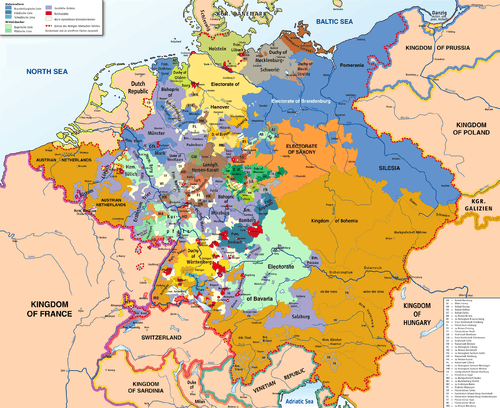

The lengthy tractations surrounding the mediatization process usually involved the French Foreign Minister Talleyrand. The states that benefited from or were saved from mediatization were expected to pay fees and form alliances with the French Republic, then the new Napoleonic Empire.[4]
Final Recess of February 1803
The Final Recess of the Reichsdeputation (German: Reichsdeputationshauptschluss Latin: Recessus principalis deputationis imperii) was a resolution passed on 25 February 1803 by the Imperial Diet of the Holy Roman Empire. It proved to be the last significant law enacted by the Empire before its dissolution in 1806.
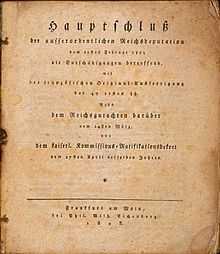
Based on a plan agreed in June 1802 between France and Austria, and broad principles outlined in Article 7[5] the Treaty of Lunéville of 1801, the law established a major redistribution of territorial sovereignty within the Empire, to compensate numerous German princes for their possessions to the west of the Rhine that had been annexed by France as a result of the wars of the French Revolution. The Treaty had referred only to the compensation of "hereditary princes", which excluded from any claim to compensation the ecclesiastical princes (prince-electors, prince-bishops, imperial abbots), Free Imperial Cities and Imperial Knights who had also been dispossessed.
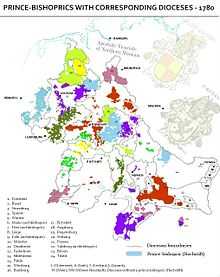
The Final Recess was ratified unanimously by the Imperial Diet in March, 1803, and was approved by the emperor, Francis II, the following month. However, the emperor made a formal reservation in respect of the reallocation of votes within the Imperial Diet, as the balance between Protestant and Catholic states had been shifted heavily in the former's favour.
The redistribution was achieved by a combination of two processes: secularization of ecclesiastical principalities, and mediatization of nearly all the Free imperial cities.
Secularization
From the re-establishment of the Holy Roman Empire by the Salian and Saxon Emperors in the 10th and 11th centuries, the feudal system had turned Germany and northern Italy into a vast network of territories of various sizes each with its own specific privileges, titles and autonomy. To help administer Germany in the face of growing decentralization and local autonomy, many bishoprics, abbeys and convents throughout Germany were granted temporal estates by successive Emperors. The personal appointment of bishops by the Emperors had sparked the investiture controversy, and in its aftermath the emperors were unable to use the bishops for this end. Following this, some of the bishops and abbots had begun to run their territories as temporal lords as opposed to spiritual lords. In the course of the Reformation, several of the prince-bishoprics were secularized, mostly to the benefit of Protestant princes. In the later sixteenth century the Counter-Reformation attempted to reverse some of these secularizations, and the question of the fates of secularized territories became an important one in the Thirty Years War (1618–1648). In the end, the Peace of Westphalia confirmed the secularizations which had already occurred, but also stabilized the situation.

In 1794, the armies of revolutionary France overran the Rhineland, and by the Treaty of Campo Formio in 1797, the Holy Roman emperor, Francis I of Austria, recognized French annexation of all imperial territories west of the Rhine river. By granting them new realms, the emperor sought to compensate the now stateless or diminished monarchs who lost their lands. The only available lands were those held by the Prince-Bishops, so most were secularised and dispersed amongst the monarchs of Germany.
The territory of secularized ecclesiastical principalities was usually annexed whole to a neighboring secular principality or, in the case of several prince-abbeys, granted to one of the princes or imperial counts whose lands on the west bank of the Rhine had been annexed by France. Only three survived for a relatively short time as non-secular states: the Archbishopric of Mainz, which became the Archbishopric of Regensburg, incorporating the latter bishopric and part of the archbishopric, and the lands of the Teutonic Knights and Knights of Saint John. Also of note is the former Archbishopric of Salzburg, which was secularised as a duchy with an increased territorial scope, and was also made an electorate.
Monasteries and abbeys lost their means of existence as they had to abandon their lands, and most were closed. The remaining ecclesiastical states were also secularized after the end of the Holy Roman Empire in 1806.The lands of the Knights of Saint John were secularized in 1806, Regensburg was annexed by Bavaria in 1809, and in the same year Napoleon dissolved the Teutonic Knights and gave their lands to neighboring princes, particularly the King of Württemberg.
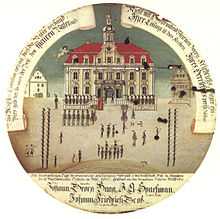
The outcome of the Final Recess of 1803 was the most extensive redistribution of property in German history before 1945. Approximately 73,000 km2 of ecclesiastical territory, with some 2.36 million inhabitants and 12.72 million guildens per annum of revenue was transferred to new rulers.[6] The rationale behind the Final Recess had been to compensate those rulers who had lost territory to France, but considerably more territory was gained through massive secularization: Baden received over seven times as much territory as it had lost, Prussia nearly five times. Hanover gained the Prince-Bishopric of Osnabrück, even though it had lost nothing. Austria also did very well.[7]
The position of the established Roman Catholic Church in Germany, the Reichskirche, was not only diminished, it was nearly destroyed. The Church lost its constitutional role in the Empire; most of the Catholic universities were closed, as well as thousands of monasteries; and many Catholic foundations closed down. The Reichsdeputationshauptschluss did to German land ownership what the Revolution had done to France.[8]
Secularised states
Bishops and archbishops
-
 Augsburg
Augsburg -
 Bamberg
Bamberg -
 Basel
Basel -
Brixen
-
 Chur
Chur -
 Cologne
Cologne -
 Constance
Constance -
 Eichstätt
Eichstätt -
 Freising
Freising -
 Hildesheim
Hildesheim -
 Liège
Liège -
 Lübeck
Lübeck -
.svg.png) Mainz
Mainz -
 Münster
Münster -
 Osnabrück
Osnabrück -
 Paderborn
Paderborn -
 Passau
Passau -
 Regensburg
Regensburg -
 Salzburg
Salzburg -
 Speyer
Speyer -
 Strasbourg
Strasbourg -
 Trent
Trent -
 Trier
Trier -
 Worms
Worms -
 Würzburg
Würzburg -
 Baindt
Baindt -
 Berchtesgaden
Berchtesgaden -
 Beuron
Beuron -
 Buchau
Buchau -
 Corvey
Corvey -
 Elchingen
Elchingen -
 Ellwangen
Ellwangen -
 Essen
Essen -
 Fulda
Fulda -
 Gutenzell
Gutenzell -
 Heggbach
Heggbach -
 Heiligkreuztal
Heiligkreuztal -
 Herford
Herford -
 Kaisheim (Kaisersheim)
Kaisheim (Kaisersheim) -
 Kempten
Kempten -
 Marchtal
Marchtal -
 Niedermünster-in-Regensburg
Niedermünster-in-Regensburg -
 Neresheim
Neresheim -
 Ochsenhausen
Ochsenhausen -
 Obermünster-in-Regensburg
Obermünster-in-Regensburg -
 Petershausen
Petershausen
Abbeys, convents, and provostries
-
 Quedlinburg
Quedlinburg -
 Rot an der Rot
Rot an der Rot -
 Rottenmünster
Rottenmünster -
 Salem (Salmansweiler)
Salem (Salmansweiler) -
 Schöntal
Schöntal -
 Schussenried
Schussenried -
 Söflingen
Söflingen -
 Stablo-Malmedy
Stablo-Malmedy -
 St. Blasien
St. Blasien -
 St. Kornelimünster
St. Kornelimünster -
 St. Emmeran
St. Emmeran -
 St. Gall
St. Gall -
 Thorn
Thorn -
 Weingarten
Weingarten -
 Weissenau
Weissenau -
 Werden-Helmstedt
Werden-Helmstedt -
 Wiblingen
Wiblingen -
 Zwiefalten
Zwiefalten
Mediatization
Although the number of German states had been steadily decreasing since the Thirty Years' War, there still remained approximately 200 states by the advent of the French republic. The defeat of the First Coalition resulted in the secularization of the ecclesiastical states and the annexation by France of all lands west of the Rhine.
Allies of Napoleon obtained gains in both territory and status on a number of occasions in the following years.
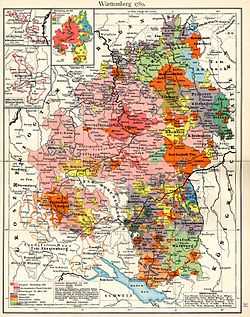
Mediatization transferred the sovereignty of small secular states to their larger neighbours. In addition to about 100 principalities, all but a handful of the Imperial cities would also be annexed to their neighbours.
In 1803, most of the free cities in Germany were mediatised. On 12 June 1806, Napoleon established the Confederation of the Rhine to extend and help secure the eastern border of France. In reluctant recognition of Napoleon's dismemberment of imperial territory, on 6 August 1806, the Holy Roman Emperor Francis II declared the Empire abolished, and claimed as much power as he could retain as ruler of the Habsburg realms. To gain support from the more powerful German states, the former Holy Roman Emperor accepted, and Napoleon encouraged, those that remained to mediatise minor neighbouring states.
Before the Battle of Waterloo and the final abdication of Napoleon in 1815, the Congress of Vienna was held from 1814 to 1815 by the Great Powers to redraw the borders of Europe. It was decided the mediatised principalities, free cities and secularised states would not be recreated. Instead their former rulers were to enjoy an improved aristocratic status, being deemed equal to the still-reigning monarchs for marital purposes, and entitled to claim compensation for their losses. But it was left to each of the annexing states to compensate mediatised dynasties, and the latter had no international right to redress if dissatisfied with the new regime's reimbursement decisions.
Mediatized principalities
-
.png) Anhalt-Bernburg-Schaumburg-Hoym: Prince of Anhalt-Bernburg-Hoym 1806
Anhalt-Bernburg-Schaumburg-Hoym: Prince of Anhalt-Bernburg-Hoym 1806 -
 Arenberg: Prince of Arenberg 1810
Arenberg: Prince of Arenberg 1810 -
 Aspremont-Lynden: Count of Aspremont-Lynden 1806
Aspremont-Lynden: Count of Aspremont-Lynden 1806 -
 Auersperg: Prince of Auersperg 1806
Auersperg: Prince of Auersperg 1806 -
 Bentheim: Count of Bentheim-Bentheim and Steinfurt 1806; Count of Bentheim-Tecklenburg-Rheda 1806
Bentheim: Count of Bentheim-Bentheim and Steinfurt 1806; Count of Bentheim-Tecklenburg-Rheda 1806 -
 Bentinck: Count of Aldenburg-Bentinck 1807
Bentinck: Count of Aldenburg-Bentinck 1807 -
 Boyneburg-Bömelberg: Baron of Boyneburg-Bömelberg 1806
Boyneburg-Bömelberg: Baron of Boyneburg-Bömelberg 1806 -
 Castell: Count of Castell-Castell 1806; Count of Castell-Rüdenhausen 1806
Castell: Count of Castell-Castell 1806; Count of Castell-Rüdenhausen 1806 -
 Colloredo: Prince of Colloredo-Mansfeld 1806
Colloredo: Prince of Colloredo-Mansfeld 1806 -
 Croÿ: Prince of Croÿ-Dulmen 1806
Croÿ: Prince of Croÿ-Dulmen 1806 -
 Dietrichstein: Prince of Dietrichstein 1806
Dietrichstein: Prince of Dietrichstein 1806 -
 Erbach: Count of Erbach-Erbach 1806; Count of Erbach-Fürstenau 1806; Prince of Erbach-Schönberg 1806
Erbach: Count of Erbach-Erbach 1806; Count of Erbach-Fürstenau 1806; Prince of Erbach-Schönberg 1806 -
 Esterházy de Galántha: Prince of Esterházy 1806
Esterházy de Galántha: Prince of Esterházy 1806 -
 Fugger: Prince of Fugger-Babenhausen 1806; Count of Fugger-Glött 1806; Count of Fugger-Kirchberg-Weissenhorn 1806; Count of Fugger-Kirchheim 1806; Count of Fugger-Nordendorf 1806
Fugger: Prince of Fugger-Babenhausen 1806; Count of Fugger-Glött 1806; Count of Fugger-Kirchberg-Weissenhorn 1806; Count of Fugger-Kirchheim 1806; Count of Fugger-Nordendorf 1806 -
 Fürstenberg: Prince of Fürstenberg-Pürglitz 1806
Fürstenberg: Prince of Fürstenberg-Pürglitz 1806 -
 Giech: Count of Giech 1806
Giech: Count of Giech 1806 -
 Grävenitz: Count of Grävenitz 1806
Grävenitz: Count of Grävenitz 1806 -
 Harrach: Count of Harrach zu Rohrau und Thannhausen 1806
Harrach: Count of Harrach zu Rohrau und Thannhausen 1806 -
 Hesse: Elector of Hesse-Kassel (or Hesse-Cassel) 1807;
Hesse: Elector of Hesse-Kassel (or Hesse-Cassel) 1807;  Landgrave of Hesse-Homburg 1806
Landgrave of Hesse-Homburg 1806 -
 Hohenlohe: Prince of Hohenlohe-Bartenstein 1806; Prince of Hohenlohe-Ingelfingen 1806; Prince of Hohenlohe-Jagstberg 1806; Count of Hohenlohe-Kirchberg 1806; Prince of Hohenlohe-Langenburg 1806; Count of Hohenlohe-Waldenburg-Schillingsfürst 1806
Hohenlohe: Prince of Hohenlohe-Bartenstein 1806; Prince of Hohenlohe-Ingelfingen 1806; Prince of Hohenlohe-Jagstberg 1806; Count of Hohenlohe-Kirchberg 1806; Prince of Hohenlohe-Langenburg 1806; Count of Hohenlohe-Waldenburg-Schillingsfürst 1806 -
 Isenburg: Prince of Isenburg 1814; Count of Isenburg-Büdingen 1806; Count of Isenburg-Meerholz 1806; Count of Isenburg-Wächtersbach 1806
Isenburg: Prince of Isenburg 1814; Count of Isenburg-Büdingen 1806; Count of Isenburg-Meerholz 1806; Count of Isenburg-Wächtersbach 1806 -
 Kaunitz-Rietberg: Prince of Kaunitz-Rietberg 1806
Kaunitz-Rietberg: Prince of Kaunitz-Rietberg 1806 -
 Khevenhüller-Metsch: Prince of Khevenhüller-Metsch 1806
Khevenhüller-Metsch: Prince of Khevenhüller-Metsch 1806 -
 Königsegg: Count of Königsegg-Aulendorf 1806
Königsegg: Count of Königsegg-Aulendorf 1806 - Kuefstein: Count of Kuefstein-Greillenstein 1806
-
 Leiningen: Prince of Leiningen 1806; Count of Leiningen-Alt-Westerburg 1806; Count of Leiningen-Billigheim 1806; Count of Leiningen-Neudenau; 1806 Count of Leiningen-Neu-Westerburg 1806
Leiningen: Prince of Leiningen 1806; Count of Leiningen-Alt-Westerburg 1806; Count of Leiningen-Billigheim 1806; Count of Leiningen-Neudenau; 1806 Count of Leiningen-Neu-Westerburg 1806 -
Leyen: Prince of Leyen 1814
-
 Limburg-Styrum: Count of Limburg-Styrum-Styrum 1806; Count of Limburg-Styrum-Borkelö 1806; Count of Limburg-Styrum-Bronchhorst 1806
Limburg-Styrum: Count of Limburg-Styrum-Styrum 1806; Count of Limburg-Styrum-Borkelö 1806; Count of Limburg-Styrum-Bronchhorst 1806 -
 Lobkowicz: Prince of Lobkowicz 1806
Lobkowicz: Prince of Lobkowicz 1806 -
 Löwenstein-Wertheim: Count of Löwenstein-Wertheim-Freudenberg 1806; Prince of Löwenstein-Wertheim-Rosenberg 1806
Löwenstein-Wertheim: Count of Löwenstein-Wertheim-Freudenberg 1806; Prince of Löwenstein-Wertheim-Rosenberg 1806 -
 Looz und Corswarem: Duke of Looz-Corswarem 1806
Looz und Corswarem: Duke of Looz-Corswarem 1806 -
 Metternich: Prince of Metternich 1806
Metternich: Prince of Metternich 1806 -
 Neipperg: Count of Neipperg 1806
Neipperg: Count of Neipperg 1806 -
 Nesselrode: Count of Nesselrode 1806
Nesselrode: Count of Nesselrode 1806 -
 Orsini and Rosenberg: Prince of Orsini and Rosenberg 1806
Orsini and Rosenberg: Prince of Orsini and Rosenberg 1806 -
 Ortenburg: Count of Ortenburg-Neuortenburg 1806
Ortenburg: Count of Ortenburg-Neuortenburg 1806 -
 Ostein: Count of Ostein 1806
Ostein: Count of Ostein 1806 -
 Öttingen: Prince of Öttingen-Öttingen 1806; Prince of Öttingen-Spielberg 1806; Prince of Oettingen-Wallerstein 1806
Öttingen: Prince of Öttingen-Öttingen 1806; Prince of Öttingen-Spielberg 1806; Prince of Oettingen-Wallerstein 1806 -
 Pappenheim: Count of Pappenheim 1806
Pappenheim: Count of Pappenheim 1806 -
 Platen-Hallermund: Count of Platen-Hallermund 1806
Platen-Hallermund: Count of Platen-Hallermund 1806 -
 Plettenberg: Count of Plettenberg-Wittem 1806
Plettenberg: Count of Plettenberg-Wittem 1806 -
 Pückler and Limpurg: Count of Pückler and Limpurg 1806
Pückler and Limpurg: Count of Pückler and Limpurg 1806 -
 Quadt: Count of Quadt-Isny 1806
Quadt: Count of Quadt-Isny 1806 -
 Rechberg and Rothenlöwen: Count of Rechberg and Rothenlöwen 1806
Rechberg and Rothenlöwen: Count of Rechberg and Rothenlöwen 1806 -
.svg.png) Rechteren-Limpurg: Count of Rechteren 1806
Rechteren-Limpurg: Count of Rechteren 1806 -
 Salm: Wild- and Rhinegrave of Salm-Horstmar 1806; Prince of Salm-Kyrburg 1810; Count of Salm-Reifferscheid-Dyck 1806; Count of Salm-Reifferscheid-Hainsbach 1806; Prince of Salm-Reifferscheid-Krautheim 1806; Prince of Salm-Salm 1810
Salm: Wild- and Rhinegrave of Salm-Horstmar 1806; Prince of Salm-Kyrburg 1810; Count of Salm-Reifferscheid-Dyck 1806; Count of Salm-Reifferscheid-Hainsbach 1806; Prince of Salm-Reifferscheid-Krautheim 1806; Prince of Salm-Salm 1810 -
 Sayn-Wittgenstein: Prince of Sayn-Wittgenstein-Berleburg 1806; Prince of Sayn-Wittgenstein-Hohnstein 1806
Sayn-Wittgenstein: Prince of Sayn-Wittgenstein-Berleburg 1806; Prince of Sayn-Wittgenstein-Hohnstein 1806 -
 Schaesberg: Count of Schaesberg-Thannheim 1806
Schaesberg: Count of Schaesberg-Thannheim 1806 -
 Schlitz genannt von Görtz: Count of Schlitz genannt von Görtz 1806
Schlitz genannt von Görtz: Count of Schlitz genannt von Görtz 1806 -
 Schönborn: Count of Schönborn-Wiesentheid 1806
Schönborn: Count of Schönborn-Wiesentheid 1806 -
 Schönburg: Count of Schönburg-Penig-Vorderglauchau-Wechselburg 1806; Count of Schönburg-Rochsburg-Hinterglauchau 1806; Prince of Schönburg-Waldenburg 1806
Schönburg: Count of Schönburg-Penig-Vorderglauchau-Wechselburg 1806; Count of Schönburg-Rochsburg-Hinterglauchau 1806; Prince of Schönburg-Waldenburg 1806 -
 Schwarzenberg: Prince of Schwarzenberg 1806
Schwarzenberg: Prince of Schwarzenberg 1806 -
 Sickingen: Count of Sickingen 1806
Sickingen: Count of Sickingen 1806 -
 Sinzendorf: Prince of Sinzendorf 1806
Sinzendorf: Prince of Sinzendorf 1806 -
 Solms: Count of Solms-Baruth 1806; Prince of Solms-Braunfels 1806; Prince of Solms-Hohensolms-Lich 1806; Count of Solms-Laubach 1806; Count of Solms-Rödelheim-Assenheim 1806; Count of Solms-Rödelheim und Assenheim 1806; Count of Solms-Wildenfels 1806
Solms: Count of Solms-Baruth 1806; Prince of Solms-Braunfels 1806; Prince of Solms-Hohensolms-Lich 1806; Count of Solms-Laubach 1806; Count of Solms-Rödelheim-Assenheim 1806; Count of Solms-Rödelheim und Assenheim 1806; Count of Solms-Wildenfels 1806 -
 Stadion:
Stadion:  Count of Stadion-Thannhausen 1806;
Count of Stadion-Thannhausen 1806;  Count of Stadion-Warthausen 1806
Count of Stadion-Warthausen 1806 -
 Starhemberg: Prince of Starhemberg 1806
Starhemberg: Prince of Starhemberg 1806 -
 Sternberg-Manderscheid: Countess of Sternberg-Manderscheid 1806
Sternberg-Manderscheid: Countess of Sternberg-Manderscheid 1806 -
.png) Stolberg:
Stolberg:  Prince of Stolberg-Rossla 1806;
Prince of Stolberg-Rossla 1806; .png) Prince of Stolberg-Stolberg 1806;
Prince of Stolberg-Stolberg 1806;  Prince of Stolberg-Wernigerode 1809
Prince of Stolberg-Wernigerode 1809 -
 Thurn und Taxis: Prince of Thurn und Taxis 1806
Thurn und Taxis: Prince of Thurn und Taxis 1806 -
 Törring: Count of Törring-Jettenbach 1806
Törring: Count of Törring-Jettenbach 1806 -
 Trauttmansdorff-Weinsberg: Prince of Trauttmansdorff 1806
Trauttmansdorff-Weinsberg: Prince of Trauttmansdorff 1806 -
.svg.png) Waldbott von Bassenheim: Count of Waldbott von Bassenheim 1806
Waldbott von Bassenheim: Count of Waldbott von Bassenheim 1806 -
 Waldburg: Prince of Waldburg-Waldsee 1806; Prince of Waldburg-Wurzach 1806; Prince of Waldburg-Zeil 1806
Waldburg: Prince of Waldburg-Waldsee 1806; Prince of Waldburg-Wurzach 1806; Prince of Waldburg-Zeil 1806 -
 Waldeck: Count and Countess of Waldeck-Limpurg 1806
Waldeck: Count and Countess of Waldeck-Limpurg 1806 -
 Wallmoden: Count of Wallmoden-Gimborn 1806
Wallmoden: Count of Wallmoden-Gimborn 1806 -
 Wartenberg: Count of Wartenberg-Roth 1806
Wartenberg: Count of Wartenberg-Roth 1806 -
 Wied: Prince of Wied-Neuwied 1806; Prince of Wied-Runkel 1806
Wied: Prince of Wied-Neuwied 1806; Prince of Wied-Runkel 1806 -
 Windisch-Grätz: Prince of Windisch-Grätz Elder line 1806
Windisch-Grätz: Prince of Windisch-Grätz Elder line 1806 -
 Wurmbrand-Stuppach: Count of Wurmbrand-Stuppach 1806
Wurmbrand-Stuppach: Count of Wurmbrand-Stuppach 1806
As the Houses of Ostein, Sinzendorf and Wartenberg became extinct after the mediatization but before 1830, they are not always counted among the Mediatised Houses. For varying reasons, Aspremont-Lynden, Bentinck, Bretzenheim, Limburg-Styrum and Waldeck-Limpurg are also sometimes excluded. Hesse-Homburg was never considered sovereign by Hesse-Darmstadt and therefore was not technically mediatised, and Hesse-Kassel (or Hesse-Cassel) was annexed into the Kingdom of Westphalia but later had its sovereignty restored. The Schönburgs had been mediatised to the Elector of Saxony in the 18th century and were only counted amongst the Mediatised Houses at the Electors' insistence.
Mediatized free imperial cities
|
Most of the mediatizations occurred in 1806 after the creation of the Confederation of the Rhine. Also mediatised 1806–1814 were several states created by Napoleon for his relatives and close allies. These include:
-
 Prince of Aschaffenburg 1806
Prince of Aschaffenburg 1806 -
 Grand Duke of Frankfurt 1814
Grand Duke of Frankfurt 1814 -
2.svg.png) King of Westphalia 1813
King of Westphalia 1813 -
 Grand Duke of Würzburg 1814
Grand Duke of Würzburg 1814
The only free cities in Germany not abolished in 1803 were:
-
 Augsburg (abolished 1805)
Augsburg (abolished 1805) -
 Bremen
Bremen -
 Frankfurt (abolished 1866)
Frankfurt (abolished 1866) -
 Hamburg
Hamburg -
 Lübeck (abolished 1937)
Lübeck (abolished 1937) -
 Nuremberg (abolished 1806)
Nuremberg (abolished 1806)
Later mediatizations were:
-
 Arenberg (annexed to France in 1810, and not re-established in 1814)
Arenberg (annexed to France in 1810, and not re-established in 1814) -
 Isenburg and Leyen (mediatised in 1814 by the Congress of Vienna for being too loyal to Napoleon)
Isenburg and Leyen (mediatised in 1814 by the Congress of Vienna for being too loyal to Napoleon) -
 Salm (several states of Salm survived to 1811 and 1813)
Salm (several states of Salm survived to 1811 and 1813) -
.png) Stolberg-Stolberg and Stolberg-Wernigerode (annexed by Prussia in 1815).
Stolberg-Stolberg and Stolberg-Wernigerode (annexed by Prussia in 1815).
Consequences
The mediatization brought about a massive change to the political map of Germany. Literally hundreds of states were eliminated, with only around forty surviving. A number of the surviving states made significant territorial gains (most notably Baden, Bavaria, and Hesse-Darmstadt); and Baden, Hesse-Kassel, and Württemberg gained status by being made electorates (to replace three that had been lost in the changes). Of the imperial cities, only Augsburg, Bremen, Frankfurt am Main, Hamburg, Lübeck, and Nuremberg survived as independent entities.
| Losses | Gains | |
|---|---|---|
| 2,000 km² 140,000 people |
12,000 km² 600,000 people | |
| 10,000 km² 600,000 people |
14,000 km² 850,000 people | |
| 450 km² 30,000 people |
2,000 km² 240,000 people | |
| 400 km² 30,000 people |
1,500 km² 120,000 people |
See also
- Confederation of the Rhine
- Congress of Vienna
- Holy Roman Empire
- Free imperial city
- French period
- Mediatisation
- Napoleon I
- Treaty of Campo Formio
Sources
 Texts on Wikisource:
Texts on Wikisource:
- Arenberg, Jean Engelbert. The Lesser Princes of the Holy Roman Empire in the Napoleonic Era. Dissertation, Georgetown University, Washington, D.C., 1950 (later published as Les Princes du St-Empire a l'epoque napoleonienne., Louvain: Publications universitaires de Louvain, 1951).
- Gollwitzer, Heinz. Die Standesherren. Die politische und gesellschaftliche Stellung der Mediatisierten 1815–1918. Stuttgart 1957 (Göttingen 1964)
- Reitwiesner, William Addams. "The Meaning of the Word Mediatized".
- Fabianek, Paul: Folgen der Säkularisierung für die Klöster im Rheinland - Am Beispiel der Klöster Schwarzenbroich und Kornelimünster, 2012, Verlag BoD, ISBN 978-3-8482-1795-3
References and notes
- ↑ In the present context, secularization means "the transfer (of property) from ecclesiastical to civil possession or use" (Webster's Encyclopedic Unabridged Dictionary of the English Language, 1989.
- ↑ Several prince-abbeys were secularised then given as a secular principality to a prince whose land on the left bank of the Rhine had been annexed to France.
- ↑ The total of 200 or 300 states that is often given represents the number of states with "voice and vote" at the Diet (Reichstag) in the 18th century. It accounts for over 95% of the territory and population of Germany then. However, if we count, as we should, all the separate territories enjoying imperial immediacy, then the total is 1700–1800, mostly the tiny territories belonging to the Imperial Knighthood plus a number of immediate lordships (Herrschafts), subjected to the authority of the emperor only, and consequently, more or less "independent" like any other state of the Empire. Gagliardo, J., Reich and Nation, The Holy Roman Empire as Idea and Reality, 1763–1806, Indiana University Press, 1980, p. 4–5.
- ↑ After receiving an acceptable financial offer from one minor prince, the humorous Talleyrand wrote in the margin of the treaty concerning him: "La République française est charmée de faire connaissance avec le prince von Reuss" (The French Republic is delighted to get acquainted with prince von Reuss), Alan Schom, One Hundred Days, Napoleon's Road to Waterloo, Michael Joseph Ltd, 1992, p. 94
- ↑ Art. 7. "And since the transfer of territory from the Empire to the French Republic has dispossessed in whole or in part several Princes and Imperial Estates, and since it is the collective responsibility of the Holy Roman Empire to bear the losses resulting from the provisions of this treaty, it is agreed between H.M. the Emperor and King, in his name and on behalf of the German Empire, and the French Republic, that, in accordance with the principles formally established at the Congress of Rastatt, the Empire will be required to grant to the hereditary princes who lose their possessions on the left bank of the Rhine a compensation that will be taken from within the said Empire, according to the terms of an arrangement to be determined later".
- ↑ Whaley, J., Germany and the Holy Roman Empire (1493-1806), Oxford University Press, 2011, vol. 2, p. 620.
- ↑ Whaley, p. 621
- ↑ Whaley, p. 623.
External links
| Wikisource has the text of the 1911 Encyclopædia Britannica article Mediatization. |
- (German) Full text, including the preamble
- (German) The full text of the mediatization PDF of 25 February 1803